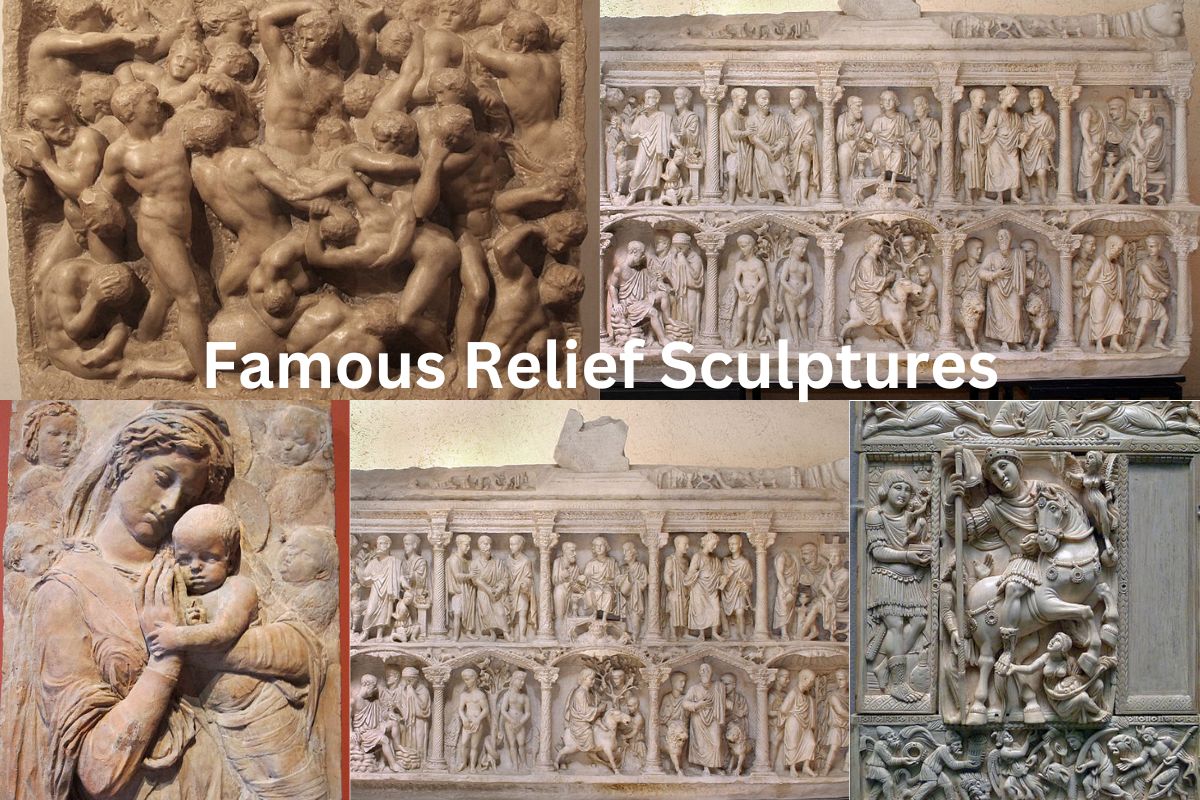Relief sculpture is a type of artwork where figures or designs are carved or molded onto a flat surface, creating the illusion of depth and dimensionality.
Unlike sculptures in the round, which can be viewed from all angles, relief sculptures are typically designed to be viewed from a single vantage point.
Relief sculptures can range in size from small, intricate carvings to massive, monumental works, and can be made from a variety of materials, including stone, wood, bronze, and plaster.
Throughout history, relief sculptures have been used to depict religious and mythological stories, historical events, and portraits of individuals or groups.
The level of detail and skill required to create relief sculptures has made them a popular form of artistic expression for centuries.
Famous Relief Sculptures
1. Harbaville Triptych
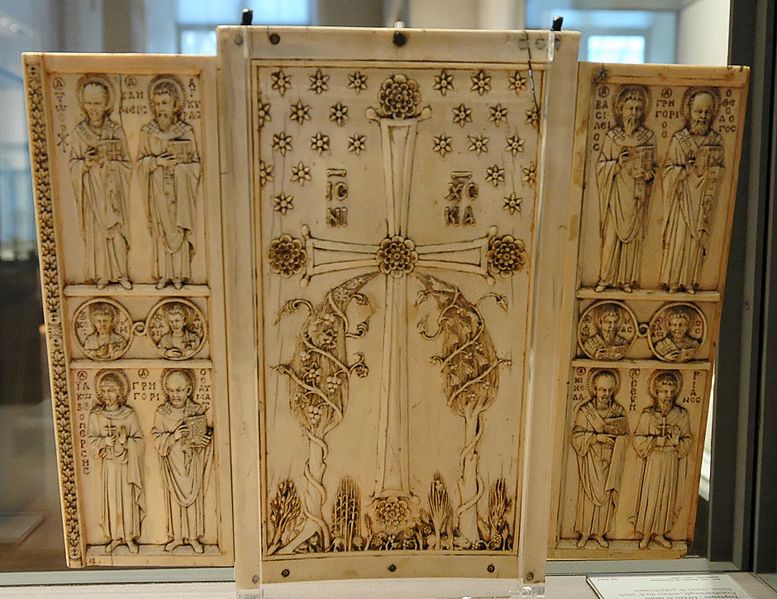
The Harbaville Triptych is a mid-tenth-century Byzantine ivory triptych depicting a Deesis and other saints that is presently housed in the Louvre. Some figures still have traces of coloring on them.
It is considered the finest and best-preserved of the “Romanos group” of ivories from a workshop in Constantinople, most likely close to the Imperial Court.
The triptych is entirely carved on all sides, with additional saints on the outsides of the side leaves and an elaborate decorative scheme on the rear of the central leaf.
The origins of ivory are unknown. It was named after its first known owner, the antiquarian Louis-François Harbaville (1791-1866), who acquired it from his in-laws, the Arras-based Beugny de Pommeras family.
It was purchased for the Louvre by Harbaville’s grandsons and heirs in 1891.
2. Barberini Ivory
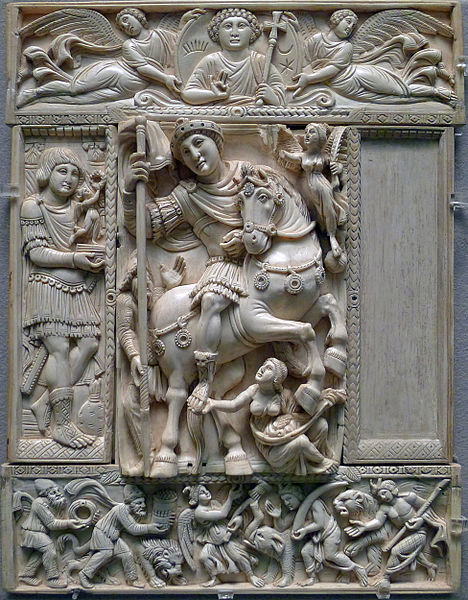
The Barberini ivory is a Byzantine ivory leaf from a Late Antiquity imperial diptych now housed in the Louvre in Paris. It depicts the emperor as a victorious victor.
It is generally dated to the first part of the sixth century and is credited to an imperial workshop at Constantinople, with Justinian, or possibly Anastasius I or Zeno, as the emperor.
It is an important historical document because it is associated with Queen Brunhilda of Austria. On the back is a list of Frankish monarchs’ names, all of whom were Brunhilda’s relatives, signifying her high position. Brunhilda had the list engraved and presented it to the church as a votive image.
The work mixes a classic theme of the victorious emperor’s entire power, crowned by Victory, whose universal dominion is synonymous with peace and prosperity, and a Christian victory brought about by Christ’s patronage and blessing of the emperor.
It adds a new cosmic hierarchy into the narrative of the Roman Empire’s triumph, making it a highly political work intended to serve as imperial propaganda. The craftsmanship is of such high quality that it can be linked to an imperial workshop in Constantinople.
3. Battle of the Centaurs
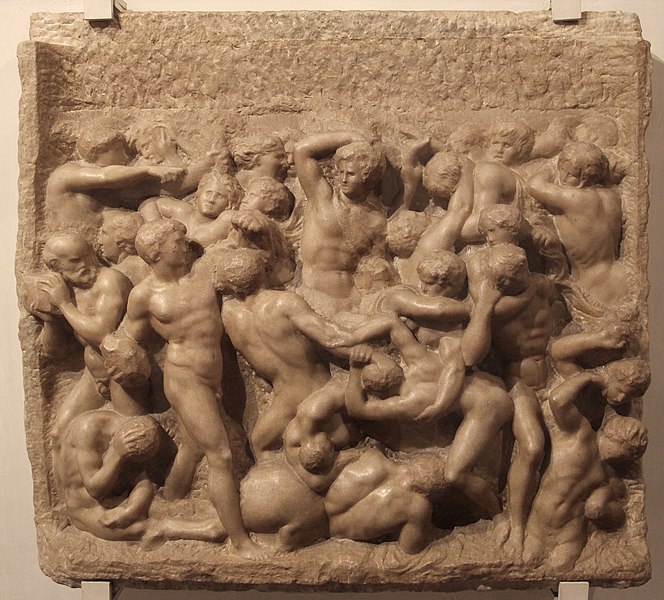
The Battle of the Centaurs is a relief sculpture made around 1492 by the Italian Renaissance artist Michelangelo. It was Michelangelo’s final work while under the patronage of Lorenzo de’ Medici, who died shortly after it was completed.
The marble sculpture, inspired by a classical relief by Bertoldo di Giovanni, depicts the fabled fight between the Lapiths and the Centaurs.
The narrative, which was a famous topic of art in ancient Greece, was suggested to Michelangelo by the classical scholar and poet Poliziano. The sculpture is currently on display at the Casa Buonarroti in Florence, Italy.
In many ways, Michelangelo’s Battle of the Centaurs sculpture foreshadowed his future sculptural path. Michelangelo had abandoned the then-current method of working on a distinct plane in favor of working in three dimensions.
It was also the first sculpture Michelangelo constructed without the use of a bow drill, as well as the first sculpture to be completed with the marks of the subbia chisel remaining as a final surface.
Whether left incomplete on purpose or not, the piece is notable in the tradition of “non finito” sculpting method. Michelangelo considered it his best early work and a visual reminder of why he should have concentrated his attention on sculpture.
4. Madonna and Child with Four Cherubs
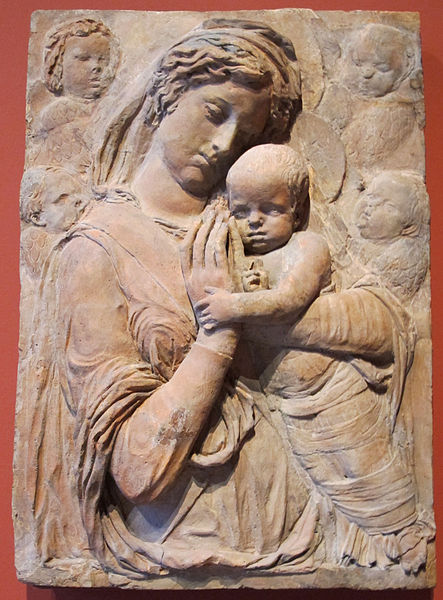
Madonna and Child with Four Cherubs is a terracotta sculpture by Donatello that was purchased by the Bode-Museum in Berlin in 1888.
Mary and Jesus’ heads touch in a manner similar to the artist’s Pazzi Madonna, which retains certain medieval symbolism.
The work was severely damaged in the 1945 fire, with breaks in various locations and the loss of its polychromy traces.
5. Ludovisi Battle Sarcophagus
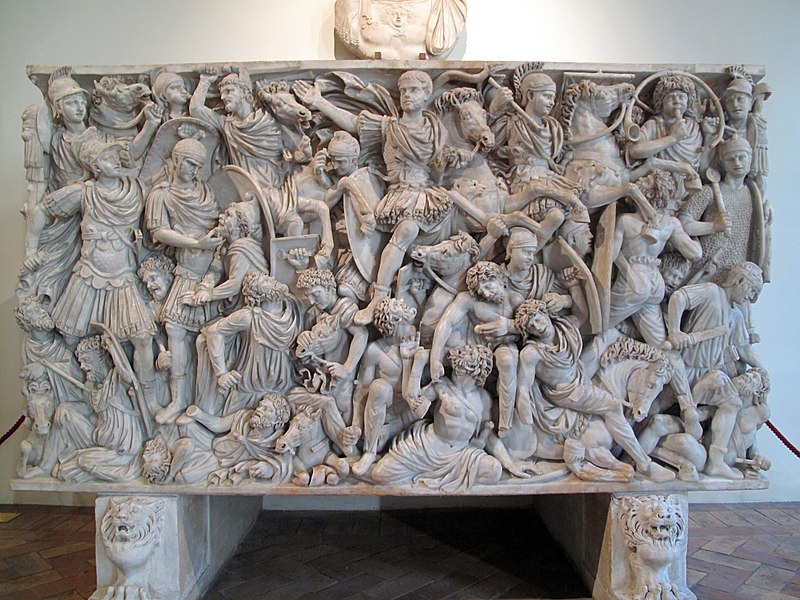
The Ludovisi Battle sarcophagus, also known as the “Great” Ludovisi sarcophagus, is an ancient Roman coffin discovered in 1621 in the Vigna Bernusconi, a mausoleum near the Porta Tiburtina.
The Via Tiburtina Sarcophagus is another name for it, however additional sarcophagi have been discovered there.
It is famous for its densely crowded, anti-classical composition of “writhing and highly emotive” Romans and Goths, and it is an example of the battle scenes popular in Roman art during the Third Century Crisis.
The sarcophagus, discovered in 1621 and named after its first modern owner, Ludovico Ludovisi, is presently on exhibit at the Palazzo Altemps in Rome, which is part of the National Museum of Rome since 1901.
6. Sarcophagus of Junius Bassus
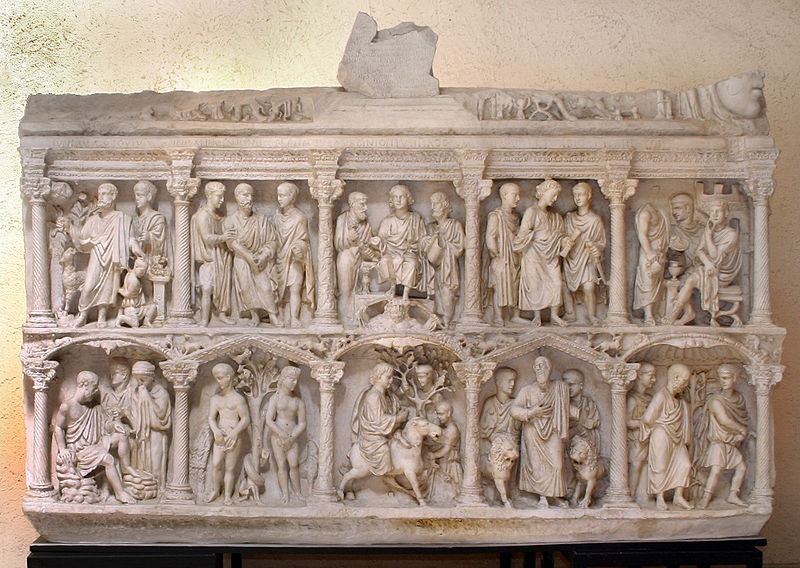
Junius Bassus’ Sarcophagus is made of marble. Junius Bassus, who died in 359, was buried in an early Christian tomb. It’s been called “probably the single most famous piece of early Christian relief sculpture.”
The sarcophagus was originally housed in or beneath Old St. Peter’s Basilica, was rediscovered in 1597, and is presently housed beneath the modern basilica in the Museo Storico del Tesoro della Basilica di San Pietro in the Vatican. The base is about 4 x 8 x 4 feet.
This sarcophagus, along with the Dogmatic sarcophagus in the same museum, is one of the oldest surviving high-status sarcophagi, with extensive carvings of Christian themes and a complex iconographic program encompassing the Old and New Testaments.
7. Confederate Memorial Carving
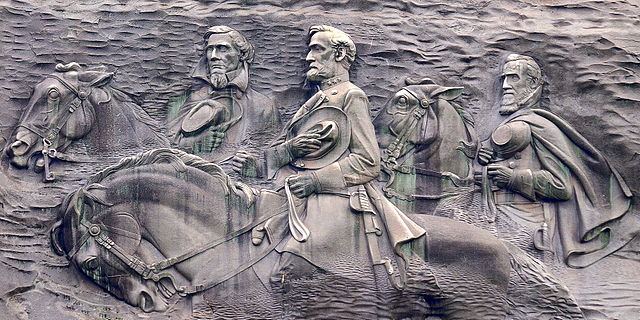
The Confederate Memorial Carving, the world’s largest bas-relief sculpture, depicts three Confederate leaders from the Civil War: President Jefferson Davis, Generals Robert E. Lee and Thomas J. “Stonewall” Jackson (on their favorite horses, Blackjack, Traveller, and Little Sorrel, respectively).
The sculpture is 42 feet (13 meters) deep in the mountain, 90 feet (27 meters) tall, 190 feet (58 meters) wide, and 400 feet (120 meters) above the earth.
8. Madonna of the Stairs
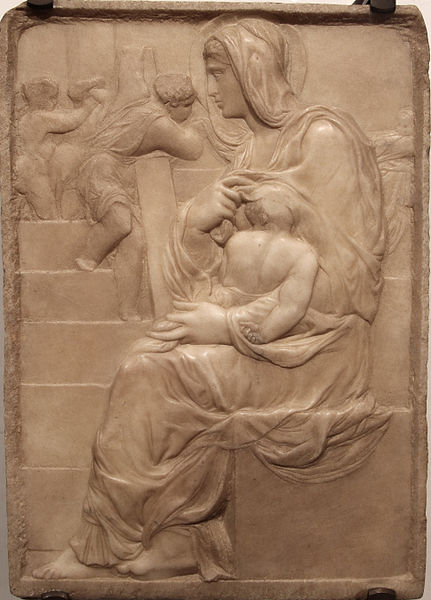
Michelangelo’s Madonna of the Stairs (or Madonna of the Steps) is a relief sculpture in Florence’s Casa Buonarroti. It was created about 1490, when Michelangelo was roughly fifteen years old.
Michelangelo’s first two sculptures were this and the Battle of the Centaurs. The Madonna of the Stairs was originally mentioned as a work of Michelangelo in the 1568 edition of Giorgio Vasari’s Lives of the Most Excellent Painters, Sculptors, and Architects.
The sculpture is currently on display at the Casa Buonarroti in Florence, Italy.
The work is an obvious homage to Donatello’s stiacciato low reliefs, as Vasari also noted, both in technique and sizes plans with millimeter thickness variations, and both in iconography, beginning with the scale pattern with pronounced steps and foreshortened handrails, as seen in the Feast of Herod in Lille.
The Madonna, sitting on a square stone block and facing away, occupies the entire height of the relief, from edge to edge, with the severity and monumentality of classical reliefs.
9. The Feast of Herod
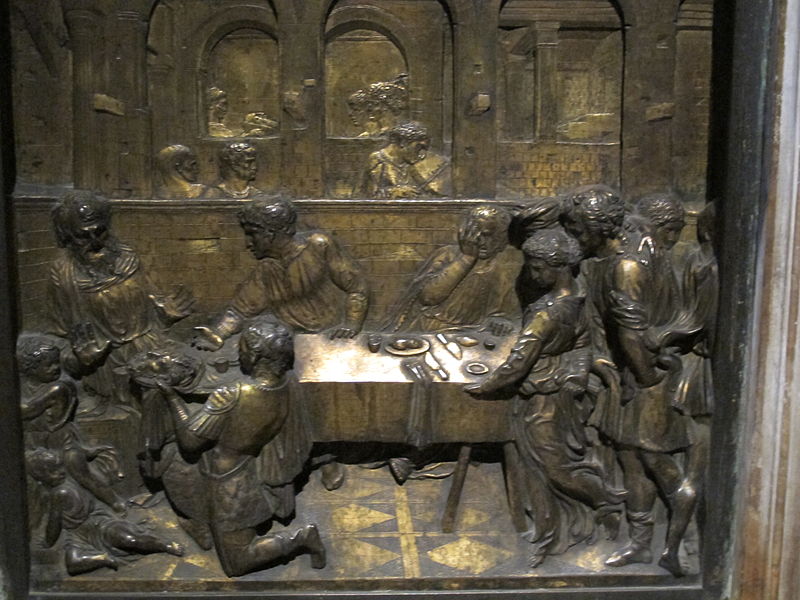
Many of Donatello’s most famous sculptures were created ‘in the round,’ but he also created a few brilliant works in relief.
The Feast of Herod is one such sculpture that depicts the well-known Biblical account of the feast hosted by the evil King Herod.
According to the Bible, during this time, Herod’s daughter, Salome, sought the head of John the Baptist, which King Herod grudgingly agreed to supply.
The relief sculpture by Donatello depicts the beheading of John the Baptist. Most historians and scholars believe the sculpture was completed in 1427 and was one of Donatello’s earliest relief works.
An executioner is shown in the sculpture presenting the head of John the Baptist, which he is holding up to show King Herod.
10. Florence Baptistery South Portal Door Gilded Bronze
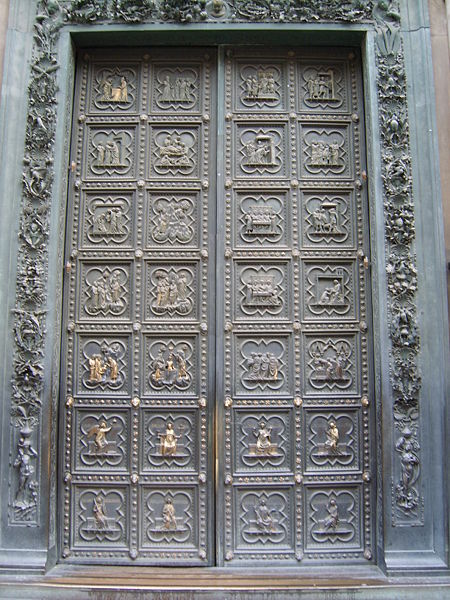
The Baptistery of St. John, also known as the Florence Baptistery, is a minor basilica in Florence, Italy.
The octagonal-shaped baptistery can be seen in both the Piazza del Duomo and the Piazza San Giovanni, opposite the Campanile di Giotto and the Florence Cathedral.
The Baptistery was built between 1059 and 1128 in the Florentine Romanesque style, making it one of the city’s oldest constructions.
The Baptistery is famous for its three sets of magnificent bronze doors with sculptured reliefs.
The north and east entrances were designed by Lorenzo Ghiberti, while the south entrance was designed by Andrea Pisano. The east doors were dubbed the Gates of Paradise by Michelangelo.

